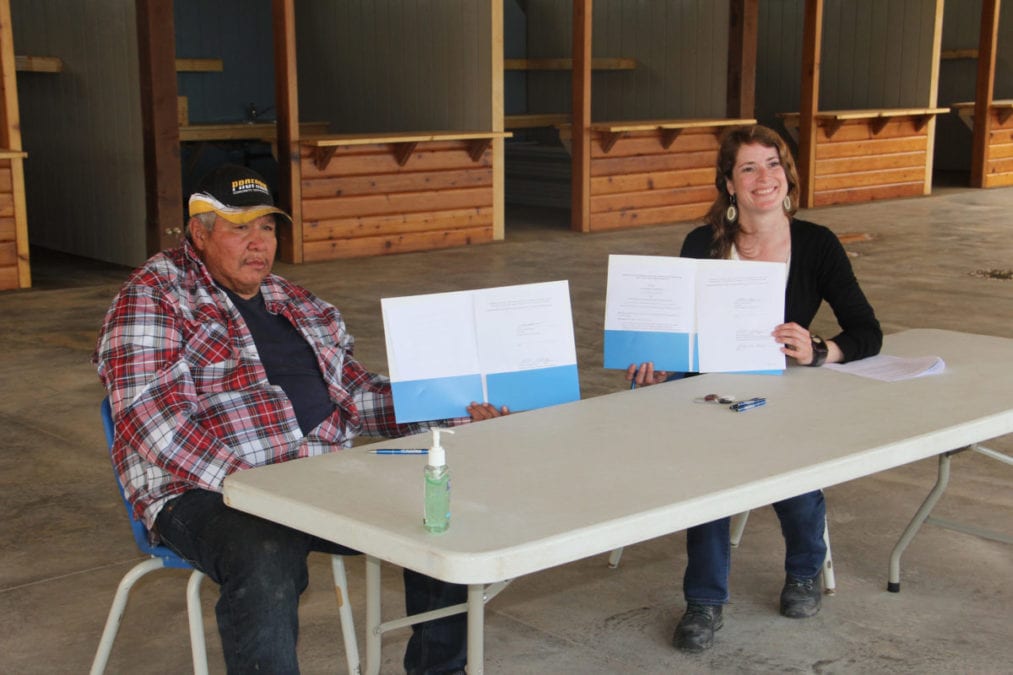The GNWT and the Tu Cho Fishers Co-operative have confirmed their commitment to revitalizing the fishing industry of Great Slave Lake.

Paul Bickford/NNSL photo
That commitment took the form of a memorandum of understanding signed on July 22 by Industry, Tourism and Investment Minister Katrina Nokleby and Cameron Beaverbones, the president of the Tu Cho Fishers Co-operative.
Following the signing at Fisherman's Wharf in Hay River, Nokleby was asked if there hadn't been such a commitment before.
Previously, it was probably more like a tacit understanding, she said.
"It wasn't something that was done on paper or formalized. And we just wanted to show the Tu Cho that we are committed to working with them on this project and that it's not going to be us coming and saying this is how everything is going to be."
Beaverbones is pleased with the memorandum of understanding.
"It means lots to the fishermen," he said. "We all wanted this for a long time."
Beaverbones believes the agreement will mean more money for fishermen for their catches.
For years, one of the big issues for the fishing industry in Hay River has been the need for a new fish plant.
Nokleby believes the memorandum of understanding brings the plant a step closer.
"We just want to solidify our commitment to actually getting it built and getting it done," she said.
A tender for construction was cancelled last year after the two bids for the work were both more than $14 million, which was significantly over budget.
In January of 2019, the federal government and the GNWT announced joint funding of $8.9 million to build a new fish plant.
Nokleby would not commit to a timetable for when a new plant might be built, explaining a redesign is underway because of the budget issues.
"We couldn't afford it," she said. "So we've had to go back and scale down."
A redesign is being finalized with the assistance of Memorial University of Newfoundland, she said.
"So we've gone to them to engage to see about use of other parts of the fish, so that we can do fertilizer and roe and things where we use more parts of the fish. And that allows the fishers to not have to kind of gut and clean in the field. They just bring them in, and then the plant will take care of them. We use more of the fish, we have more products to sell."
Beaverbones hopes construction of the new plant might begin next summer.
The July 22 memorandum of understanding outlines a shared vision to improve returns for fishers; create new jobs in processing, packaging, selling and transporting fresh fish and secondary products for market; and provide a greater choice for NWT residents shopping for locally-produced food.
The agreement defines six areas in which the parties will come together to make their shared vision a reality.
Nokleby listed the highlights as building a fish plant capable of processing and packaging up to 1.5 million pounds of fish per year, positioning the Tu Cho Co-operative to ensure that producers have a direct say and even ownership in the industry, attracting and training new fishers, improving and modernizing existing fleets and resources, establishing pickup points where fishers can drop their catch for transportation to the Hay River plant, revitalizing the winter fishery, and creating awareness and demand for Great Slave Lake fish across the North and elsewhere.
The Tu Cho Fishers Co-operative is a branch of the NWT Fishermen's Federation.
Last year, 26 different licensed fishers delivered fish to the existing plant in Hay River.